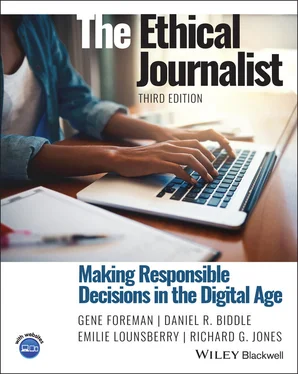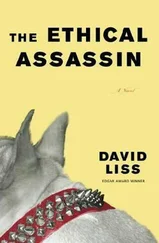Gene Foreman - The Ethical Journalist
Здесь есть возможность читать онлайн «Gene Foreman - The Ethical Journalist» — ознакомительный отрывок электронной книги совершенно бесплатно, а после прочтения отрывка купить полную версию. В некоторых случаях можно слушать аудио, скачать через торрент в формате fb2 и присутствует краткое содержание. Жанр: unrecognised, на английском языке. Описание произведения, (предисловие) а так же отзывы посетителей доступны на портале библиотеки ЛибКат.
- Название:The Ethical Journalist
- Автор:
- Жанр:
- Год:неизвестен
- ISBN:нет данных
- Рейтинг книги:5 / 5. Голосов: 1
-
Избранное:Добавить в избранное
- Отзывы:
-
Ваша оценка:
- 100
- 1
- 2
- 3
- 4
- 5
The Ethical Journalist: краткое содержание, описание и аннотация
Предлагаем к чтению аннотацию, описание, краткое содержание или предисловие (зависит от того, что написал сам автор книги «The Ethical Journalist»). Если вы не нашли необходимую информацию о книге — напишите в комментариях, мы постараемся отыскать её.
Praise for the Third Edition of The Ethical Journalist
ANN MARIE LIPINSKI,
Praise for the Earlier Editions
GENE ROBERTS,
ALICIA C. SHEPARD, The Ethical Journalist
The Ethical Journalist
The Ethical Journalist — читать онлайн ознакомительный отрывок
Ниже представлен текст книги, разбитый по страницам. Система сохранения места последней прочитанной страницы, позволяет с удобством читать онлайн бесплатно книгу «The Ethical Journalist», без необходимости каждый раз заново искать на чём Вы остановились. Поставьте закладку, и сможете в любой момент перейти на страницу, на которой закончили чтение.
Интервал:
Закладка:
Technological and economic transition has caused tensions in today’s news media.
More people are getting their news digitally, but online sites are struggling to find stable sources of revenue.
Although advertisers have historically paid for news coverage, consumers are now being asked to pay for digital subscriptions.
Native advertising has found a home on news websites, where stringent rules are needed to protect integrity of news content.
The business and news executives of media companies frequently have a strained relationship, mainly because their cultures are so different.
Case Study: Sharing Ad Profits, Creating a Crisis
Thoughts to Take With You
Glossary
Index
Foreword
By Philip B. Corbett
The writer is associate managing editor for standards of The New York Times .
It feels like ancient history, but it wasn’t so long ago that our whole job in the newsroom of The New York Times was to put out the print paper once a day. It seemed hard at the time – unforgiving deadlines, lots of stress and pounding on keyboards. Now, looking back, I wonder what we actually did all day. One print edition every 24 hours? Sounds pretty cushy.
Everything’s different now, for The Times and every other news organization. A daily print paper, yes, many newsrooms still do that. But now we also have minute-by-minute digital deadlines, 24 hours a day. Constant social media posting on an ever-expanding range of platforms. Video. Audio. Interactive graphics. Live chats. Newsletters. Every day, it seems, brings a new journalistic tool, and every innovation brings new questions about journalistic standards and ethics.
What’s appropriate for a journalist to post on Twitter, and what’s off limits? Are there different standards for corrections on breaking-news alerts? What are the anonymity rules for podcast interviews? Do reporters always have to identify themselves on Facebook? Are tools like facial-recognition technology fair game for journalists? Does Google change how we think about archived stories?
It can feel deeply disorienting. But even as the journalistic ground shifts under our feet, it’s crucial to remember this: The most important parts of our work are not changing at all.
Get the facts right. Be fair and empathetic. Guard your independence. When it’s time to hit “publish,” tell your readers, viewers and listeners the truth, as best you can.
This book explores those fundamental principles and how to apply them, whether in traditional stories or new formats. You’ll wrestle with how to balance a subject’s right to privacy with a reader’s right to know. You’ll think hard about whether your personal views might skew your reporting, and how to cultivate sources while guarding your independence. You’ll consider whether your empathy as a person ever conflicts with your obligations as a journalist. And you’ll confront the complex challenges of covering a diverse society with sensitivity and rigor.
The basic principles – accuracy, fairness, independence – are clear. But the case studies in this book demonstrate something I’ve learned and relearned during nearly four decades in journalism. For many of the most important decisions we make, there’s no single, obvious right answer. Even when we agree on the principles, it’s not always clear how they apply to a messy set of circumstances. There are hard calls, gray areas and difficult balances to strike. This textbook doesn’t provide a convenient list of the right answers to all the problems you’ll face. It helps you learn how to think about those problems.
As you grapple with these issues of journalistic standards and ethics, here’s one simple tactic I often find helpful. Imagine a thoughtful reader – fair-minded and reasonable, but tough and skeptical as well. Not your mother, who’ll applaud everything you do. And not a bad-faith critic whose whole goal is to undermine your efforts. But a reader who cares about the topic you’re covering and wants you to get it right.
Now imagine that this fair-minded but skeptical reader knows everything about how you reported, wrote or edited the story you’re working on. Heard the very conversations you’re having with your editor. Saw what you chose to put in and what you left out. Knew how you dealt with your sources. Watched while you or your colleagues decided what picture to use, what anecdote to lead with, what headline to write.
What if you walked that reader through everything you did and explained every decision you made? Would the reader trust your journalism more, or less? If there are some things about your work that you’d rather a reader not know – well, maybe you should think again about that part of the process.
Sometimes this thoughtful-reader test isn’t just a theoretical exercise. One big step forward in journalistic practices in recent years is the trend toward transparency – a greater willingness to show our work and explain how we did it. It’s increasingly common for reporters to lay out how many sources they interviewed, how they first learned about a crucial document, what elements of a story they still haven’t nailed down. But even if you don’t put those details into a story, imagine what you would say to a reader who wanted to know.
Earning and keeping that reader’s trust is the ultimate goal of all our ethics guidelines. This book will help prepare you for that challenge.
Preface
By Gene Foreman
I am pleased to present this thoroughly updated third edition of The Ethical Journalist and to welcome three esteemed former colleagues as coauthors: Daniel R. Biddle, Emilie Lounsberry, and Richard G. Jones. All of us have worked at The Philadelphia Inquirer , and all of us have taught journalism at the college level.
Our book is intended to inform your professional life. Technically, it is published as a textbook for college courses in journalism ethics and communications ethics, and as the ethics textbook in a course combining journalism ethics and law. We hope that practicing journalists will also find it useful for its comprehensive discussion of the standards of the profession.
If you fit those categories of student journalist or practicing journalist, you will find yourself addressed directly in this book. We reach out to you in two ways: first, to help you learn to make ethically defensible decisions in the practice of journalism; and, second, to give you the benefit of the thinking of generations of professionals and scholars that resulted in today’s consensus guidelines for ethical conduct.
With these goals in mind, we have divided the book into two parts. Part I examines ethics in a general way, explains the importance of ethics to journalism, and outlines a decision‐making strategy. Part II discusses subject areas in which journalists frequently confront ethics questions, and it offers real-life case studies in which you can decide how to respond to the ethics challenges that the actual journalists faced.
Throughout the book, the consensus guidelines are explained, not to dictate your decision‐making but to offer a starting point for thinking through the issues. The idea is that you don’t have to start from a zero base; you can build on the best thinking of those who have gone before. Where there is disagreement in the profession, we have noted that, too. In several instances we advocate for what we consider to be the best practice.
Teachers who have used previous editions of The Ethical Journalist will notice a modest restructuring. Recognizing Donald Trump’s profound influence on the practice of journalism, we have devoted an entire chapter in Part I to “the Trump effect.” In Part II, each of the first four chapters is devoted to an in-depth discussion of a guiding principle of the Society of Professional Journalists ethics code, and we have added a chapter on journalists’ use of social media. Finally, the chapters on journalist misconduct and “the business of journalism” have been moved to the end of the book, not to minimize their importance but to separate them from the Part II chapters focusing on practical ethics issues.
Читать дальшеИнтервал:
Закладка:
Похожие книги на «The Ethical Journalist»
Представляем Вашему вниманию похожие книги на «The Ethical Journalist» списком для выбора. Мы отобрали схожую по названию и смыслу литературу в надежде предоставить читателям больше вариантов отыскать новые, интересные, ещё непрочитанные произведения.
Обсуждение, отзывы о книге «The Ethical Journalist» и просто собственные мнения читателей. Оставьте ваши комментарии, напишите, что Вы думаете о произведении, его смысле или главных героях. Укажите что конкретно понравилось, а что нет, и почему Вы так считаете.











